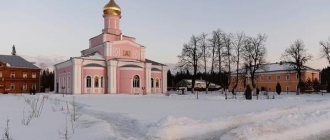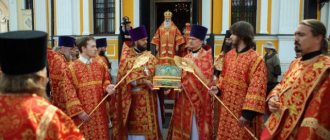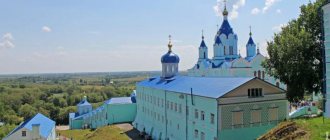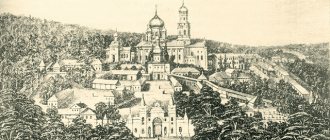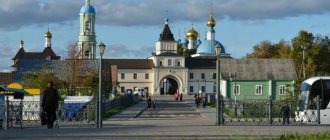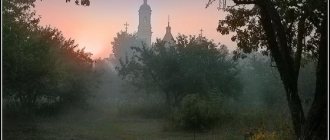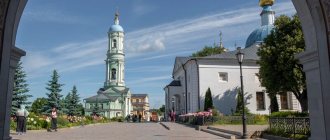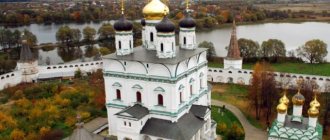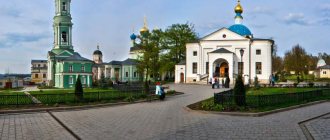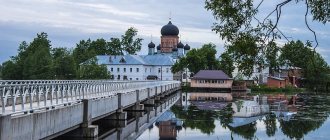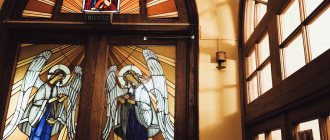St. Smolensk Zosimova men's hermitage
Storm
It all started with a thunderstorm, which began on the eve of the feast of the Kazan Icon of the Mother of God. I asked my friend, with whom I was visiting at the dacha near the city of Alexandrov, to go to Zosima Monastery. It was raining, lightning was flashing, thunder was roaring, but I had an irresistible desire to go. A friend was sitting at her needlework by the window in a small country wooden house and embroidering an icon of the Kazan Mother of God. She didn’t want to take time off from needlework, but seeing my persistent desire, she agreed. Her three little daughters went with us. We drove along a wet road, amid the rumbles of thunder and lightning, firmly believing that the Mother of God would save us from trouble, and sang the Jesus Prayer with the children.
Zosimova Hermitage is located in a picturesque place, a few kilometers from the Arsaki railway station.
The boyar widow, Ulyana Ivanovna Zvorykina, transferred the land that belonged to her to her sons, and they donated it to the Trinity-Sergius Lavra, in honor of the souls of their parents.
The founder of the monastery is considered to be Schemamonk Zosima, who came here in the middle of the 17th century with the cell attendant of St. Sergius of Radonezh. He built a small chapel, set up a modest home for himself, dug a well, set up a small apiary, and tended to a vegetable garden.
A legend has been preserved “that the strength of Blessed Zosima lies in the fact that he showed boundless Christian love for his neighbors. He made a vow to become an eternal intercessor before God for everyone who turned to him at least once.” In the middle of the 19th century, there were cases of Zosima appearing to wood sawyers. The appearances of St. Zosima will continue in our time.
Meeting
Zosimova Hermitage is now located on the territory of a military unit, therefore, having presented our passport at the checkpoint and received a pass, we drive along a direct road to the temple, towering above the forest. We have time for the anointing and venerate the relics of St. Zosima. To the left of the entrance I notice a hieromonk, with a doll on his head, a schema-monk. He is talking to a woman, standing opposite me, but I cannot see his face, since the woman is blocking him.
“Do you want to confess,” the hieroschemamonk suddenly asks me, looking out from behind his interlocutor’s head. I am surprised by “guessing” my desire.
And now, after just a few minutes, I am kneeling at the feet of a schema-monk sitting on a chair, wearing simple Russian felt boots. Confession takes a long time.
“The Lord wants us to live together.” “Parents like it when their children are friends with each other, and so does God,” the monk says calmly, looking into my eyes. His eyes are attentive and kind.
I want to stay in the monastery to work, pray and confess.
“You can,” the hieroschemamonk answers my question, and in parting he says: forgive everyone, and then the Lord will forgive you your sins.
“What is the name of the monk, this one, with whom we just confessed?” I ask the monk on duty at the temple.
“Hieroschemamonk Zosima,” he answers.
Kittens
The service is over. The children, seeing little kittens in the courtyard of the monastery, rushed towards them. Each girl received a purring kitten. Having given the children the opportunity to play with the animals, we headed back around nine o'clock in the evening. I warned my children and my friend that I might go to a monastery.
Little four-year-old Sonya asked: “Galya, do you want to return to the monastery because of the kittens?”
- No, Sonechka, I want to work hard.
“And I would go to a monastery just because of the kittens,” said Sonya
Work days
A day later, I called my friend Anyuta and offered to work together in the monastery. She agreed and came with her father Gennady. Having received the blessing of the steward of the monastery, Father Melchizedek, we settled in the monastery hotel, receiving obedience to help in the refectory.
The main condition for staying in the monastery as laborers is attending the midnight office, which begins at 6 a.m., and the evening service at 5 p.m.
The evening service, half an hour before the start, is called by a monk who walks around the temple with a beater. He somehow beats a wooden board with a hammer in a special, beautiful way.
Anya and I sat on a wooden bench and tried to repeat these sounds with a stone. Anyuta succeeded right away, but even with great difficulty I never succeeded.
In the evening, having performed obedience in the kitchen and prayed at the evening three-hour service, we saw that there were almost as many cats in the monastery as there were monks. And they have the same quiet disposition and meekness. The kittens trustingly climbed onto our laps, and with them the mother cat. We could not deny ourselves the pleasure of being comforted by their gentle rumbling.
The silence here is special. Among the centuries-old pines, whose crowns almost reach the dome of the temple, and the cedars planted by workers, we loved to walk after evening prayer and breathe fresh air. We learned that, it turns out, in three days, July 26, is the patronal feast day of all Zosima saints.
Hieroschemamonk Zosima invited us after dinner for a conversation in his cell.
I look at the monk, and it seems to me that his face is very familiar to me, the same eyes - penetrating and kind, a look that penetrates your heart, a face that seems bleached.
We talked about ourselves, told the elder our plans, desires, he gave us advice, told us about himself. That's what we remember.
The Lord gives every person the right to choose.
When I was 14 years old, I wrote 12 pieces of paper with the professions I would like to study for, and by drawing lots I would draw a note on which was written “priest.”
One day a holy fool came to our house from nowhere. Everyone sat down at the table, and the neighbor began to knock the egg on the table to break the shell, and my mother thought to herself, “You can’t knock on the table, this is the throne of God, it would be better if you knocked on your forehead.” The holy fool took the egg from her hands and, with the words “You can’t knock on the table, it’s the throne of God that would be better if she knocked on the forehead,” he hit the egg on the forehead, mother,” Monk Zosima smiled. He also called her “nun,” and five years later my mother went to a monastery.
My mother advised me to definitely get to know him better.
When I found the house where the holy fool was staying for the night, he, instead of greeting, folded his hands and said “Bless, Father Peter” (my name was Peter then) and kissed my hand, seeing that I would become a priest.
After all, who is the holy fool? This is a blessed one, he can denounce, he behaves like a fool, and for his humility the Lord gives grace and insight.
When my mother and I raised our children, we agreed to go to a monastery. At first we went to monasteries, looked closely, and then we chose: I went to the Zosimov Hermitage, and she went to the convent in Alexandrov.
And then I had a dream. I see my mother in a dream and want to hug her, but she puts her hands in front of my chest and says “you can’t.” Some time later I find out that she was tonsured a nun. And a little later, me too.
Father Zosima explained that they went to the monastery to be closer to God.
Gennady asked how the elder treated the Old Believers, because they are ours, Russian people who believe in God. To which Father Zosima replied that even he himself found errors in the copyists of books, that it was necessary to eliminate them, but not by violence, it was necessary to explain to people.
We asked him whether he himself had doubts and unresolved questions, or whether he had reached a state where everything was clear.
“I believe in God,” the elder calmly answered. Without God nothing happens.
“The rulers and tsars of the Russian state had the goal of building a powerful state, uniting the country,” continued Gennady.
“And we have one goal,” answered Father Zosima, “to prepare the soul for the Kingdom of Heaven.”
We thanked him and asked permission to write about our conversation. He blessed.
The next day he allowed us to take communion. Before the service, he carefully placed us next to him at the crucifix, and throughout the service he directed us, told us when to say prayers, and before communion he turned to us and said: “We are all unworthy of communion, but it was given to us so that we could fight our sins.” "
On the day of Equal-to-the-Apostles Princess Olga, we were the only communicants - lay people, and when the Gospel was read, we had the feeling that the Lord was telling us: “Her many sins are forgiven because she loved a lot, and those who are forgiven little love little.” "(Luke 7:47).
Feast of the Saints of Zosima. 26 July.
We bought the book “Zosima Patericon”, Hieroschemamonk Zosima signed this book with the words “The blessing of the Holy Smolensk Zosima Hermitage be with you.”
When we read it to each other, it seemed as if the saints and ascetics themselves of the Holy Smolensk Zosimova Hermitage were teaching us the covenants of love and teaching us.
Zossimovsky saints: Rev. Schemamonk Zosima. Venerable, Scheromonk Alexy (Soloviev). St. Hieromonk Macarius (Morzhov), St. Schema-Archimandrite Ignatius (Lebedev), St. Gerasim (Mochalov), St. Hegumen Vladimir (Terentyev).
St. Scheromonk Alexy (Soloviev) , - it was he who was destined to pull out a note from the casket with the name of St. Tikhon of Moscow, the future patriarch. The election of the patriarch was to be decided by lot. Elder Alexy crossed himself three times and, without looking, took a note out of the casket.
St. Hieromonk Macarius (Morzhov) . When asked about the Antichrist, he replied that “there is no need to determine the timing of the appearance of the Antichrist, but one must live like a Christian.”
St. Schema-Archimandrite Ignatius (Lebedev) . “Children! — he wrote in letters, “strive for the things above, touching the things below, as far as bodily need requires.”
As parishioners of the Temple of the Tikhvin Icon of the Mother of God, we often visit the grave of the elder Hieroschemamonk Innocent (Oreshkin), one of the confessors of the Zosima Hermitage. There is a feeling of amazing peace and tranquility at his grave. It happened that you came, but there was turmoil in your soul... You stand, read the words of the elder “Be wise, do not grieve before your time, surrender to the will of God,” you look at the tall, centuries-old trees rustling with their branches, and it turns out that the sadness has passed. And some talked about miraculous healings from illnesses, such as drunkenness.
It seems that over these days the desert has become native to us. And all the Zosimaites, Hieroschemamonk Zosima, Father Melchizedek, with whom we had the opportunity to talk about the miracles and appearances of the Monk Zosima. Cook Sergei, with whom we worked, who, when asked how the Monk Zosima helps him, answered with a smile: “It helps to cook.” Assistant cook Dmitry, Alexandra, who takes care of a young man from an orphanage who was sheltered by the monastery for a while. How touching it was to watch this boy’s care for the kitten, which he bathed, fed and even wiped its snot with a handkerchief.
We saw neither wealth nor contentment in the monastery. On the contrary, scarcity and poverty surrounded us, as if covering an invisible treasure hidden from everyone, the one for which, as it turned out, we had come - forgiveness and love. And that is why we want to return again and again to where the air smells of pine trees, where the evening silence, like prayer, calms the restless spirit, where for dinner they give real milk and simple buckwheat porridge, where kittens trustingly lick our hands. Little Sofia was right that kittens are part of the creation of God’s world, which is worth returning to for their sake.
Vladimir region
The monastery in Arsaki surprised almost more than Alexandrov...
But first I tried to get to the Church of Boris and Gleb in Volokhovo. 56.3918, 38.5169 I didn’t bother the car. After Arsak, although there is rubble, it is very lumpy.
A couple of houses in memory of Arsaki.
The navigator stubbornly did not want to lead the direct road to the monastery... And indeed. After the railway crossing and dachas, rows of barbed wire appeared on the left, and then a checkpoint with signs, barriers and two cheerful women. I was about to turn around, but I asked, just in case - why, supposedly, there’s no way to get to the monastery? “What is this? Go now that you have arrived.” And the barrier rose. Next there was a truly abandoned military base, a monastery and a quiet drive without any checkpoints to the village of Nikulskoye. What it was I still didn’t understand. Some kind of scene from a cheap comedy about the Russian outback.
We approached the monastery slowly along a rough road in the rain, still marveling at its beauty from afar.
Brick, red brick, lots of it. I love the brick style, here is a review of Kaluga - red brick houses in Kaluga
We arrived at the monastery and the rain stopped. It's a simple miracle.
Pustyn was founded in the 1680s by Schemamonk Zosima, a native of the Trinity-Sergius Monastery. In 1923, the monastery was closed, the area around was used by engineering troops. (Now it seems like air defense). It was revived in 1992, but... you can see for yourself that there is a lot of work.
All the buildings of the monastery are from the end of the 19th - beginning of the 20th centuries - the same brick style. The Soviet-era extensions are also red brick.
Now there are about 30 people in the monastery - half workers, half brethren.
Cell building.
Abbot's corps
The monastery looks great. It has not lost its original beauty, it is partially cleared of Soviet layers and there is no excessive glamor.
Overhead chapels
Cathedral of the Smolensk Icon of the Mother of God
Zosimova Hermitage is especially beautiful in spring
St. Smolensk Zosimova men's hermitage
Cathedral from the other side
Church of All Saints
I liked it better than the cathedral.
It would seem that over the course of a century cranes, new materials, three-dimensional design, etc. have appeared, but they don’t build such beauty. For example, Dream Island in Moscow - some kind of faceless turrets, but they could have been built in our brick style.
Building near the temple
Teremok on the roof
Monastery near Alexandrov
Corner tower and former military garages
Another tower among the garages in place of the wall
Bell tower
They haven’t worked on it yet, it’s overgrown with birch trees
During Soviet times it was used as a water tower and observation post
They didn’t try to get inside, and everything was closed.
Vegetable gardens in place of the wall
The monastery is neither abandoned nor revived, there is no normal road to it, there are no tourists and pilgrims either, that’s why it is good. It’s quiet here, beautiful, without fuss...
Plekhany military town of a dozen standard houses.
There are two gorgeous ponds near the houses
Garages and vegetable gardens occupy an area as large as a village and a monastery combined.
Another pond near the monastery on the swampy Molokcha river. The road past the pond led along a dirt road with the remains of asphalt to the nearest village, and after a kilometer the normal road through the Moscow region began.
Comments:
- In contact with
Social Comments
- Description
- Trips here (3)
Description of the Smolensk-Zosimova hermitage in the village. Arsaki
The monastery owes its foundation at the end of the 17th century to Schemamonk Zosima. After the death of the schema-monk in the middle of the 18th century, the monastery ceased to exist and was truly empty for two centuries. Several attempts to revive it were unsuccessful. Only in 1848, the local manufacturer Zubov erected a wooden chapel over Zosima’s grave. In 1867, the hermitage was revived by the monks of the Trinity-Sergius Lavra, to which it was assigned.
At the end of the 19th century, under Abbot Herman, Zosimova Pustyn experienced its heyday. There were about a hundred monks here. In 1896, through the care of the abbot of the Trinity-Sergius Lavra, Archimandrite Paul, the deserts were restored after two centuries of desolation. In 1897, the large Smolensk Cathedral was built over the grave of the founder (the main temple of the desert in honor of the Smolensk Icon of the Mother of God was consecrated in 1900), a little later two more stone churches were built - All Saints and Sergius of Radonezh.
The main shrine of the monastery was the Smolensk Icon of the Mother of God, kept by the family of the Kolychev boyars, relatives of St. Philip, Metropolitan of Moscow, cell icon of St. Demetrius of Rostov. Parts of the belt of the Mother of God and the relics of St. were kept in the reliquaries next to this icon. St. George the Victorious. Also, the shrine of the monastery was a cross with a particle of the wood of the Holy Cross, brought from Athos at the beginning of the 16th century. In the Church of the Smolensk Mother of God there was the tomb of the founder of the hermitage, St. Zosima.
There was a hospice house for pilgrims at the monastery. The icons painted by Abbot Herman were considered blessed. Elder Alexy Zosimovsky, who took monastic vows here in 1898, was known hundreds of miles from the desert. He began his senility in 1906, and in 1916 he went into “complete seclusion.” He broke it in 1917 - not of his own free will: Alexy was elected as a delegate to the Local Council, and it was the elder Zosimov who took the lot from the ark with the name of Tikhon, the new patriarch of the Russian Orthodox Church.
Twice a year religious processions were directed from the monastery to two holy wells dug by Elder Zosima.
After the revolution, Zossimova Hermitage did not last long. In the first month, the monastery cathedral was robbed. After the closure of the Trinity-Sergius Lavra in November 1919, part of the relics of St. Sergius of Radonezh. At the beginning of February 1923, Abbot Herman died, and the day after his funeral a “liquidation commission” arrived from Aleksandrov, and by the summer of 1923 the hermitage was already abandoned, with ruined churches and tightly locked gates.
Subsequently, a military unit was located here. In March 1992, Bishop Evlogiy of Vladimir and Suzdal received a petition to open the monastery, and in April, on Easter, the walls of the Zosimova Hermitage again saw a prayer service and procession.
Source: https://sobory.ru/article/index.html?object=00206
Pilgrimage trips to the Smolensk-Zosimova hermitage in the village. Arsaki
- A trip from Moscow to the Smolensk-Zosimova hermitage in the village. Arsaki
- A trip from Voronezh to the Smolensk-Zosimova hermitage in the village. Arsaki
- A trip from Moscow to the Smolensk-Zosimova hermitage in the village. Arsaki
